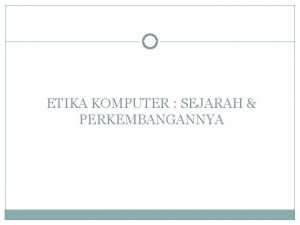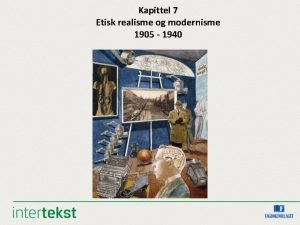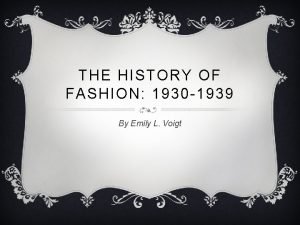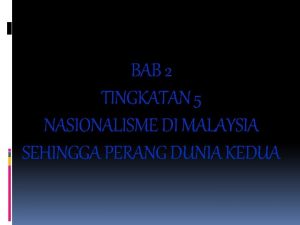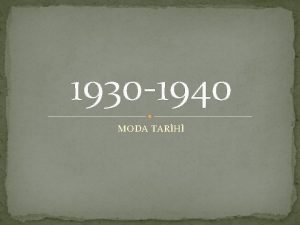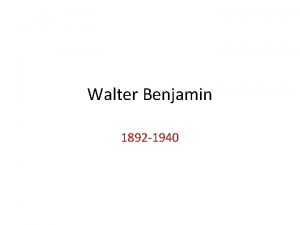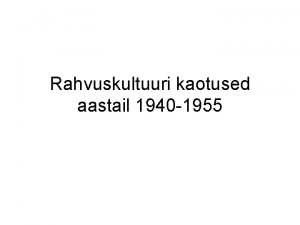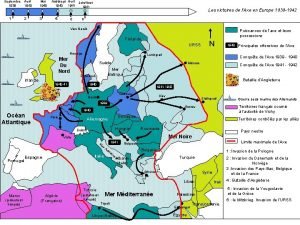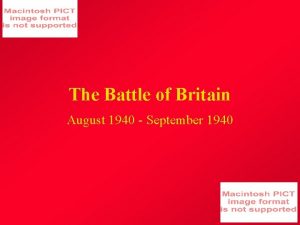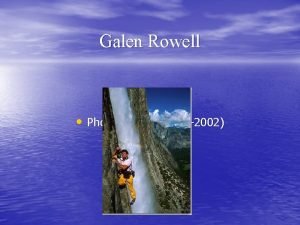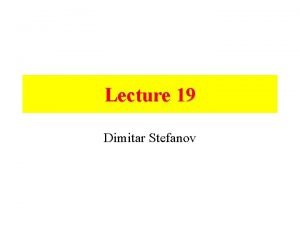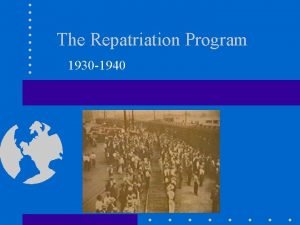The 1940 s The 1940 s was a










- Slides: 10

The 1940 s

• • The 1940 s was a decade that began on January 1, 1940 and ended on December 31, 1949. Most of the Second World War took place in the first half of the decade, which had a profound effect on most countries and people in Europe, Asia, and elsewhere. The consequences of the war lingered well into the second half of the decade, with a war-weary Europe divided between the jostling spheres of influence of the West and the Soviet Union, leading to the beginning of the Cold War. To some degree internal and external tensions in the post-war era were managed by new institutions, including the United Nations, the welfare state and the Bretton Woods system, facilitating the post–World War II boom, which lasted well into the 1970 s. • Wars: • • World war II (1939 -1945). Nazi Germany invades Poland, Denmark, Norway, Benelux and the French Republic from (1939 -1941). Germany faces the United Kingdom in the Battle of Britain (1940). It was the first major campaign to be fought entirely by air forces, and was the largest and most sustained aerial bombing campaign up until that date The United States enter World War II after the attack on Pearl Harbor on December 7, 1941. It would face the Empire of Japan in the Pacific War. The Holocaust, also known as The Shoah is the term generally used to describe the genocide of approximately six million European Jews during World War II. The German Instrument of Surrender signed (May 7– 8, 1945). Victory in Europe Day. Atomic bombings of Hiroshima and Nagasaki (August 6 and August 9, 1945); Surrender of Japan on August 15. World War II officially ends on September 2, 1945. • Major political changes: • • Establishment of the United Nations Charter (June 26, 1945) effective (October 24, 1945). Establishment of the defence alliance NATO April 4, 1949.

Film: • Oscar Winners: • • • Rebecca (1940) How green was my valley (1941) Mrs Miniver (1942) Casablanca (1943) Going my way (1944) The lost weekend (1945) The best years of our lives (1946) Gentleman's agreement (1947) Hamlet (1948) All the kings men (1949)

Some of Hollywood's most notable blockbuster films of the 1940 s include: • • • • The Maltese Falcon Double Indemnity Meet me in St Louis Casablanca The Great Dictator The big sleep The lady eve The shop around the corner Yankee doodle dandy Notorious Disney: Pinocchio Dumbo Fantasia Bambi

1940 s Fashion • Fashion in the 1940 s was a good mix of comfort and glamour. There were specific outfits that were meant for specific times of the day. Some of their designs look downright modern even by today’s standards. • Women ALWAYS wore: gloves. Preferably a pair that matches your outfit. Fur was very popular, as were animal skins. Crocodile purses, wombat collars, lambskin lining, and leather sleeves — no animal was off limits. • Clothes in the 1940 s were very bright and colourful. The brighter the better. Women’s shoes were often one of three popular colour choices: red, white or blue. • At the beginning of 1945, the roundness was first achieved by pulling the waist tight, emphasizing fullness above and below the waistline. Eventually the round look took every costume. Often the only tight parts of an outfits were at the neck, waist and wrists. • Suit jackets had round collars and round-cut hemlines, while suit skirts belled out in front. The Canadienne, a French twist on the coat of a Canadian soldier, was one of the year’s biggest fashion hits. • Evening dresses often came with farthingales to make hips seem larger and the waist thinner. • The trend of wearing “separates” continued to grow. Shirts were ready to wear, came in a wide variety of styles and mixed well with skirts. • A few horseblanket skirts appeared among the younger crowd. These unique skirts were made of plaid wool horseblankets, bound with black braid and fastened with horseblanket buckles.

History of 1940 s makeup • As the 1930 s came to a close, 1940’s women’s makeup was a huge industry, with brands such as Coty and Tangee notably becoming major rivals to cosmetic brand leaders like Max Factor, Helena Rubinstein, Maybelline, Elisabeth Arden and Dorothy Grey. Not even another world war was going to halt the advance of glamour. • The 1940 s has a look all to its own. Confident up-do hairstyles, redder than red lipsticks and nails and prominent arched eyebrows. Lipsticks in the 1940 s were red all the way and while there were now countless shades to choose from, the final objective of any young lady in the 1940 s was prominent red lips. Replacing the thin understated lip contours of the 1930 s was a deep luscious full mouth. • 1940 s beauty guides encouraged women to use a pencil to draw an outline ‘outside’ their natural lip line to enlarge her mouth. As most lipsticks were matte, Vaseline was used to add a little luster and gloss. The eyebrow was now simply kept well groomed. A girl lavished love on her brows and lashes and many handy homemade hints were followed to give a girl a bright sparkle. Max Factors Pancake foundation which appeared in the late 1930 s had many imitations but was hugely popular during the war because of its handiness. Powder Compacts had replaced the messy loose powders of the 1920 s and 1930 s. • Makeup had to be ‘on the go’ for women, many of whom found themselves working in very ‘unfeminine’ conditions in munitions and aircraft factories on both sides of the Atlantic. These gorgeous vintage compacts are much sought after now by collectors. 1940’s Rouges were often in short supply in Britain and Europe, so many women simply used their lipstick to rouge and contour their faces. Nail colouring still followed the half moon look of the previous decades but now just the tip of the nail was left unpainted – generally for practical reasons.

1940 s Makeup • Face powder was used to match the skin or to gave a nice rosy glow. To get this effect a slightly darker warmish foundation was used and then powdered over with a powder that was lighter than normal skin. To get a natural rosy look popular rouge colours were red with pinkish undertones, bright pinks with fuchsia undertones and bright roses. • For the eye dark brown or black mascara and a small eyeliner was used. Eye shadows mostly varied in muted greys and browns. Eyebrows were kept fairly natural in thickness, but were manicured into clean, well defined arches and accented by use of a dark brown pencil. • For lips all shades of red including clear bright reds, cherry reds, pinkish reds, and orange reds were popular. Two different colour plans for lipstick use existed. On the on hand the "monotone", where lipstick was used to support a glorified natural look (includes light red, reddish orange, and raspberry tones) and on the other hand the "contrast", where lips brought a definite accent (includes cherry red, crimson and vermillion shades). In any case lips should look full and soft. To effect this top lip was slightly exaggerated. • It was popular to wear nail polish according to clothes and accessories. Therefore a lot of colours were used. Especially blue-reds, brown-reds, bright reds, green, mustard yellow, black, navy blue, plum, and mauve were popular. • Basic look was a polished nail with a left out white half-moon and a white sliver at tip. • • Foundation – a shade darker than your natural. Powder – plenty of powder still, a lighter shade and patted on. Eyes -light medium browns with beige highlighting. Understated. Eyebrows – much thicker than in the 1930 s. Vaseline used to groom to shape. Lips – Reds and orange reds were the prerequisite Lashes – cake mascaras like Maybelline – still applied with a brush. Rouge – rose colours applied out from the cheek apples. Nails – Filed to a point with the tips left unpainted.


1940 s Hairstyles • Influence of hair on hair: • Film Stars • Actresses- Betty Grable, Veronica Lake, Dorothy Lamour, Rita Hayworth and Ava Gardner epitomised the glamour of the era, and provided escapism from the everyday dreariness of war. • Television was a rarity in the home, so going to the cinema was incredibly popular – just part of life for everyone. • The influence movie stars had on the public didn’t escape the notice of officials in the United States of America. Long hair was hazardous where machinery was operated, like in factories and on farms, and too many accidents were happening. In the hope of encouraging women to cut their hair short, thus reducing the risk of being injured or worse at work, they asked Veronica Lake to cut her trademark “peekaboo” long locks. Ms Lake obliged. • Throughout the decade, hair was generally between just below shoulder length or shorter. • Hair was cut with a rounded U-shape at the back, curving up towards the ears, and most haircuts had lots of layers – these were needed to create the styles. • If there was a parting, hair was generally parted to one side. • Whatever the hairstyle a woman chose, hair was worn feminine and soft, and always dressed off the face.


